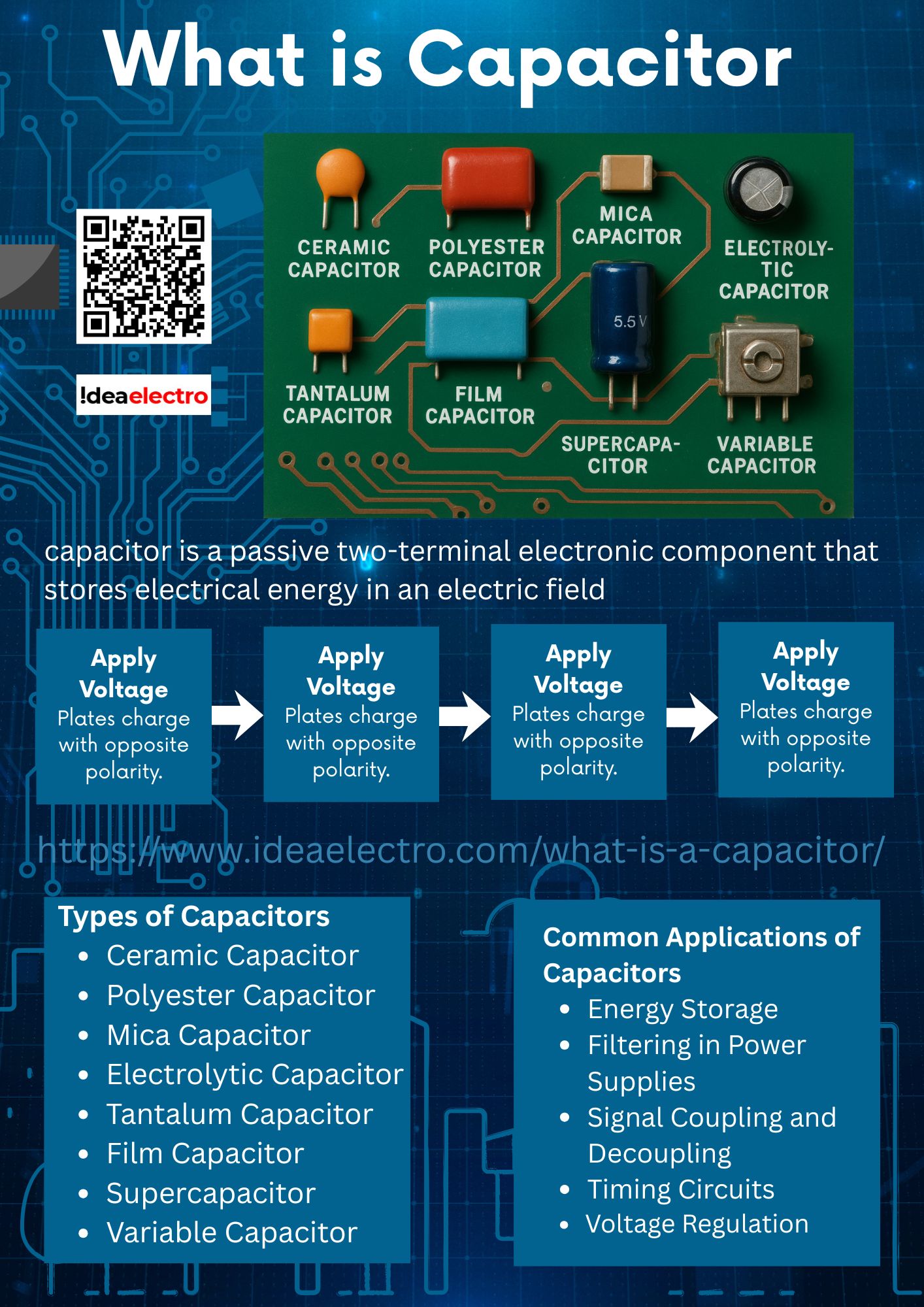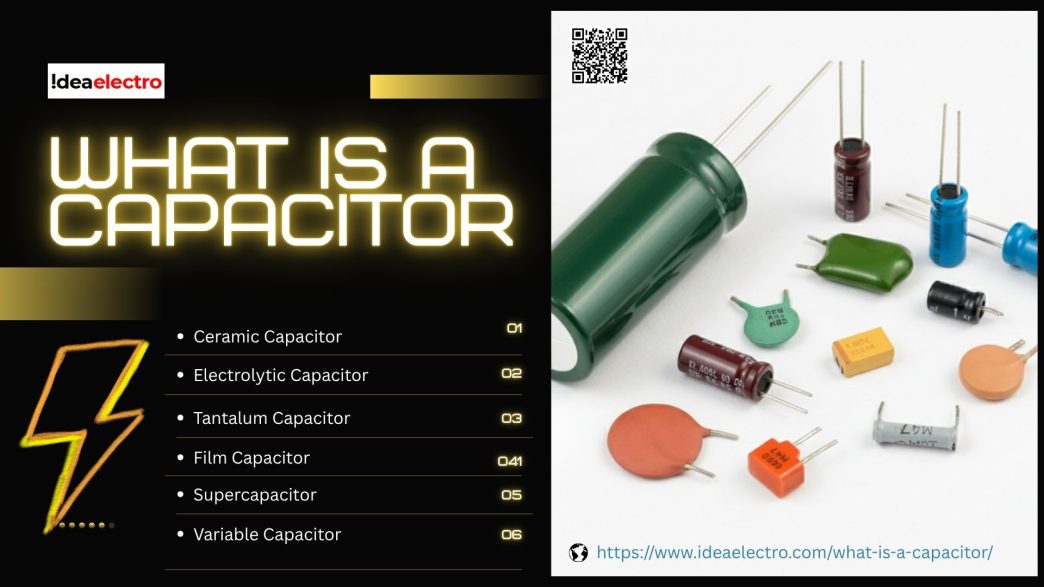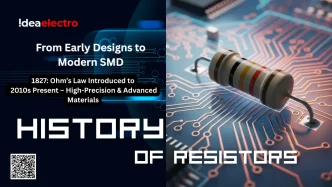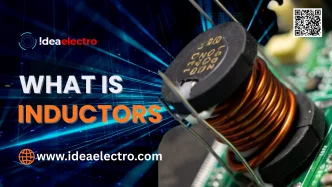A capacitor is a fundamental electronic component that acts as a tiny, rechargeable reservoir for electrical energy. Imagine it as a small battery that can be charged up and then discharged in an instant. Its simple function—to store and release electrical energy on demand—makes it one of the most ubiquitous parts in virtually every electronic circuit, from the simplest toys to the most advanced supercomputers.
The importance of the capacitor in electronics cannot be overstated. Alongside resistors and inductors, it forms one of the three core passive components, often abbreviated as “LCR” for inductor, capacitor, and resistor. These components are the basic building blocks that allow complex circuits to function. Capacitors are crucial for a wide range of tasks, including stabilizing voltage levels, filtering out unwanted electrical “noise,” and timing circuits. Without capacitors, modern electronic devices as we know them would not be possible.
Definition of a Capacitor
In formal terms, a capacitor is a passive two-terminal electronic component that stores electrical energy in an electric field. It functions by accumulating electric charges on two closely spaced surfaces that are insulated from each other. When a voltage is applied across its two terminals, an electric field develops, causing a net positive charge to collect on one conductor and a net negative charge to collect on the other. This process is known as charging, and the amount of electrical energy a capacitor can hold is determined by its capacitance.
The key characteristics of a capacitor can be summarized as follows:
- Charge Storage:Its primary function is to store electric charge, acting as a temporary energy reservoir.
- Capacitance (Farads):The capacitance, measured in Farads (F), is a numerical value that expresses how much charge a capacitor can hold at a given voltage. Most capacitors in everyday electronics are rated in microfarads (µF, one-millionth of a Farad) or picofarads (pF, one-trillionth of a Farad).
- Two Conductors:A capacitor consists of two electrical conductors, often called plates, which are separated by an insulating material.
- Dielectric Material:The space between the two conductors is filled with a non-conductive material called a dielectric, which increases the capacitor’s ability to store charge.
- Blocking Behavior:A capacitor blocks the flow of direct current (DC) but allows alternating current (AC) to pass through it.
How a Capacitor Works (Working Principle)
The operation of a capacitor is based on the formation of an electric field. When a DC voltage is applied across the capacitor’s two terminals, electrons begin to flow into one of the metal plates, giving it a negative charge. An equal amount of electrons is simultaneously drawn away from the opposite plate, leaving it with a positive charge. An electric field is established in the dielectric material between these plates, and this field is what stores the electrical energy. The charges remain separated on the plates as long as the voltage source is connected, creating a potential difference across the terminals.
A capacitor’s behavior is defined by its charging and discharging cycles. During charging, current flows momentarily until the voltage across the plates equals the source voltage. If a load, such as a resistor or LED, is then connected across the charged capacitor, it will discharge. The stored energy is released as electrons flow from the negative plate to the positive plate through the load, providing a burst of current until the potential difference drops to zero. This rapid discharge is what powers a camera flash. The process can be broken down into a few key steps:
- Charging:A voltage source is connected, causing current to flow and charge to build up on the plates.
- Energy Storage:The electric field in the dielectric holds the energy.
- Discharging:The voltage source is removed and a load is connected, allowing the stored charge to flow out as current.
Capacitor Components (Plates, Dielectric, Terminals)
A capacitor’s physical construction is straightforward but engineered for efficiency. At its most basic, it consists of two conductive plates separated by an insulating layer, all housed within a protective casing and connected to the external circuit via terminals. The materials chosen for each component directly influence the capacitor’s key properties, including its capacitance, voltage rating, and suitability for different applications.
Each component plays a critical role in determining the capacitor’s overall performance and characteristics:
- Plates (Electrodes):These conductors are typically made from metal foils or thin metallic films. Their primary function is to provide a surface area for charge to accumulate. A larger surface area (A) of the plates allows for a greater amount of charge to be stored, thereby increasing the capacitance.
- Dielectric:This is the insulating material sandwiched between the plates. It does not conduct electricity but becomes polarized by the electric field, which enhances the capacitor’s ability to store charge. The material’s relative permittivity (εr), also known as the dielectric constant, is a measure of how effective it is at increasing capacitance. Common dielectrics include ceramic, plastic film, paper, aluminum oxide, and even air.
- Casing and Terminals:The casing is an external shell that protects the internal plate-dielectric assembly from environmental damage and provides mechanical stability. The terminals are the two connecting points, usually metal leads or contact pads, that link the internal plates to the rest of the electronic circuit.

Types of Capacitors
The world of capacitors is diverse, with different types engineered to excel in specific roles. The variations primarily arise from the different dielectric materials and construction methods used, which directly impact their capacitance range, size, cost, and frequency characteristics. Selecting the right type of capacitor is a fundamental task in electronic design.
Some of the most common types of capacitors encountered in electronics include:
- Ceramic Capacitor:One of the most common types, these capacitors use a ceramic material as the dielectric. They are usually small, inexpensive, and non-polarized, meaning they can be connected in any direction in a circuit. However, their capacitance can vary with temperature and applied voltage. They are widely used for decoupling and noise suppression in high-frequency circuits.
- Polyester Capacitor: The polyester capacitor, also known as a Mylar capacitor, is a popular type of film capacitor valued for its stability and cost-effectiveness. Constructed by metalizing a thin polyester film as the dielectric, these components are non-polarized, making them suitable for AC signals and power applications. They offer a good balance of properties, including a moderately high insulation resistance and a wide capacitance range, typically from about 1 nF to 10 μF. While not ideal for high-frequency circuits due to their relatively high dielectric absorption, polyester capacitors are extensively used in general-purpose DC and audio-frequency circuits, such as coupling, decoupling, and filtering applications.
- Mica Capacitor: The mica capacitor is a classic, high-performance electronic component known for its exceptional stability and reliability. Utilizing thin sheets of natural or synthetic mica as the dielectric, these capacitors are typically constructed as stacked silver mica types. They offer very low electrical losses, high precision, and excellent temperature stability, making them virtually free of piezoelectric effects. Due to these properties, mica capacitors are ideal for high-frequency applications, resonant circuits, and precision timing devices where consistent performance is critical.
- Electrolytic Capacitor:These capacitors are polarized, so they must be connected with the correct polarity. They offer high capacitance values in a relatively small size, making them ideal for power supply circuits to smooth out voltage ripples. Their main drawbacks are a limited lifespan and a tendency to lose performance at high frequencies.
- Tantalum Capacitor:A subtype of electrolytic capacitors that uses tantalum metal. They are more stable, reliable, and smaller than aluminum electrolytics for a given capacitance, but they are also more expensive and sensitive to voltage spikes.
- Film Capacitor:These capacitors use a thin plastic film as the dielectric. They are known for their high insulation resistance, low losses, and excellent stability. They are often the preferred choice for applications requiring high precision and reliability, such as in audio circuits and power electronics.
- Supercapacitor (Electric Double-Layer Capacitor):Also known as ultracapacitors, these components have an extremely high capacitance, thousands of times greater than electrolytic capacitors. They store energy electrostatically in an electric double layer at the electrode-electrolyte interface. They excel in providing high power bursts and have an exceptionally long lifecycle, but their energy density is lower than batteries.
- Variable Capacitor:These capacitors allow for manual adjustment of their capacitance value. They are typically used in tuning circuits, such as in old radios, to select specific frequencies.
Capacitance and Formulas
Capacitance is the defining property of a capacitor, representing its ability to store electrical charge. It is defined as the ratio of the electric charge (Q) on each conductor to the voltage (V) across them, expressed by the formula C = Q/V. The unit of capacitance is the Farad (F). A one-farad capacitor can store one coulomb of charge at one volt, but in practice, most capacitors are a tiny fraction of a farad.
Several physical factors determine the capacitance of a parallel-plate capacitor, as summarized in the table below:
| Factor | Effect on Capacitance |
| Plate Area (A) | Increasing the surface area of the plates increases capacitance. |
| Distance Between Plates (d) | Decreasing the separation between plates increases capacitance. |
| Dielectric Material (εr) | Using a material with a higher dielectric constant increases capacitance. |
The relationship between these factors is elegantly captured by the fundamental capacitance formula: C = ε₀εrA/d. In this equation, C is the capacitance, A is the area of one of the plates, and d is the distance separating them. The ε₀ is the permittivity of free space (a physical constant), and εr is the relative permittivity, or dielectric constant, of the insulating material between the plates. This formula shows that to create a capacitor with high capacitance, engineers aim to maximize plate area, minimize the distance between plates, and use a dielectric material with as high a constant as possible.
Common Applications of Capacitors
Capacitors are versatile components that serve a multitude of critical functions in electronic and electrical systems. Their ability to store and release energy rapidly, block DC while passing AC, and respond to different frequencies makes them indispensable. They are the unsung heroes that ensure the smooth, stable, and reliable operation of countless devices.
Some of the most fundamental applications include:
- Energy Storage:Capacitors store electrical energy and release it quickly when needed. This is the principle behind camera flashes, where a capacitor charges up and then discharges instantly to produce a bright flash of light.
- Filtering in Power Supplies:In power supply circuits, capacitors are used to smooth out the pulsating DC output from rectifiers, reducing “ripple” voltage to create a steady, clean DC signal. They are also used to filter out high-frequency noise.
- Signal Coupling and Decoupling:Capacitors can block DC voltage while allowing AC signals to pass from one stage of a circuit to another; this is known as coupling. Conversely, decoupling capacitors are used to shunt AC noise to the ground, preventing it from interfering with the DC power supply of sensitive components like integrated circuits (ICs).
- Timing Circuits:When combined with a resistor, a capacitor forms an RC (resistor-capacitor) circuit. The time it takes for the capacitor to charge and discharge through the resistor creates a predictable time delay, which is used to control oscillators and set timing intervals in devices like timers and blinkers.
- Voltage Regulation:Capacitors help maintain voltage at a consistent level. They act as local reservoirs, supplying power during brief demand spikes and absorbing excess voltage, which stabilizes the power delivered to a circuit.
Advantages and Limitations
Capacitors offer a unique set of benefits that make them ideal for numerous applications, but they also have inherent limitations that dictate how and where they can be used. Understanding this balance is key to effective circuit design. The following table outlines some of the primary advantages and limitations of standard capacitors:
| Advantages | Limitations |
| Rapid charging and discharging | Lower energy density compared to batteries |
| Very long operational life (millions of cycles) | Cannot provide long-term power (slow discharge) |
| Simple, robust construction with no moving parts | Energy leakage (self-discharge) over time |
| Ability to deliver high peak power | Capacitance value can be influenced by temperature and voltage |
| High efficiency with minimal energy loss during charge/discharge | Electrolytic types have a limited shelf life and can degrade |
Choosing the right capacitor is therefore a matter of matching the component’s strengths and weaknesses to the demands of the application. For instance, a supercapacitor is an excellent choice for a application requiring a million charge cycles and instant power delivery, but it would be a poor choice for powering a remote control for weeks. This is why a vast array of capacitor types exists, each engineered to optimize for certain characteristics.
Difference Between Capacitor and Battery
While both capacitors and batteries store electrical energy, they do so through fundamentally different mechanisms and are suited for distinctly different roles. A battery stores energy chemically and releases it through slow, controlled electrochemical reactions, allowing it to provide a steady voltage over a long period. A capacitor, in contrast, stores energy physically in an electric field, which enables it to charge and discharge almost instantaneously. This core difference dictates their applications.
The table below provides a direct comparison of these two energy storage devices:
| Aspect | Capacitor | Battery |
| Energy Storage Method | Electrostatic (in an electric field) | Chemical (in active materials) |
| Charge/Discharge Speed | Very fast (seconds or less) | Relatively slow (minutes to hours) |
| Life Cycle | Very high (can exceed 500,000 cycles) | Lower (typically 500 to 5,000 cycles) |
| Typical Applications | Camera flashes, power conditioning, memory backup | Smartphones, electric vehicles, grid storage |
| Energy Capacity | Lower energy density | Higher energy density |
A capacitor is generally preferred over a battery in situations that require a quick burst of power, extremely fast charging, or a virtually unlimited number of charge-discharge cycles. For example, a capacitor is ideal for providing the surge of energy needed to start a motor or to maintain power to a computer’s memory during a brief power outage. For applications requiring a sustained energy supply over hours or days, a battery remains the superior choice.
Conclusion
From their humble beginnings as the Leyden jar to the advanced supercapacitors of today, capacitors have proven to be a cornerstone of electrical engineering. Their simple principle of operation—storing energy in an electric field between two plates—belies their profound importance. They are the components that enable energy storage, voltage stabilization, noise filtering, and precise timing in virtually every electronic device we use.
Understanding what a capacitor is, how it works, and the different roles it can play is fundamental for anyone with an interest in electronics. Whether you are a student, a hobbyist, or a professional engineer, appreciating the capabilities and limitations of this versatile component is key to designing and understanding the technology that shapes our modern world. The capacitor, in its elegant simplicity, remains an indispensable force in the electronic landscape.









